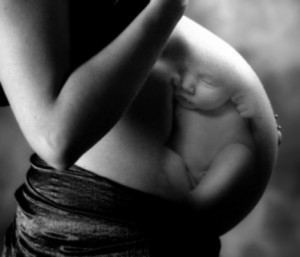Happy and Healthy
 It’s a harmless phrase, really.
It’s a harmless phrase, really.
Many an expectant parent has said it: “We’re happy as long as he’s happy and healthy.” Well intentioned and true, no doubt. Who doesn’t want their child to be happy and healthy? Pregnant women forgo champagne toasts on New Year’s Eve, take prenatal vitamins with DHA and folic acid and make countless sacrifices — all for the health of their child.
But, what if the child to be born is not perfectly healthy? How does a parent respond if the prenatal diagnosis indicates that the child has a birth defect or genetic anomaly such as Down syndrome?
Recently, while waiting with my wife for an ultrasound, I had occasion to think about such questions. In the room next door we heard the nurse call an expectant mother after she had undergone prenatal testing. The nurse reported, “No, no, we have great news for you. Everything looks good. No Down syndrome, no Trisomy, so you don’t need to worry — no need to come in, you can just keep on doing what you are doing.”
I could sense the anxiety and relief on the other side of the phone. It was clear that the woman would have been told to come in immediately if the nurse had different news to share. I could not help but wonder how often that phone call is made and how often the nurse says, “I’m sorry but I have bad news …”
When a woman receives a poor prenatal diagnosis she is likely to be crestfallen and confused, especially if she has little support. The news that a child has a disability is presented and received as an urgent matter that must be “fixed” immediately. As one mother of a disabled child wrote at BeNotAfraid.Net, “Fear is an emotion which can overwhelm a woman who has welcomed her pregnancy only to be told that something is terribly wrong. There is little information, if any, readily available to help the distraught and confused mother-to-be who wants to flee from her situation.”
What follows too often leads to a tragic decision. There is a tendency to distance oneself from that disabled child. “Options” are now considered and “termination” typically encouraged.
Sadly, Down syndrome equates to a death sentence as 90 percent of children prenatally diagnosed with the genetic disorder are aborted. Abortion is the greatest threat to persons with disabilities.
This is disheartening, but it need not be this way. Medical practitioners should approach their patients with compassion, tender love and genuine support. They can find resolve in the Church’s teaching that one with mental or physical disabilities, no matter how severe, must be treated as a unique person of incomparable worth, with the same right to life and to health care as anyone else. Every person is made in the image and likeness of God, possesses an intrinsic dignity and is precious in God’s sight.
But, teaching alone is not enough — the Christian community is called to actively support parents who face a negative prenatal diagnosis. For example, Be Not Afraid (BNA) is a unique ministry that provides a community of hope and encouragement for these parents. Making the choice for life is difficult and raising children with disabilities brings a unique set of challenges. BNA’s ministry is a tremendous resource, especially in its publication of testimonies by those who received a poor prenatal diagnosis and chose life, as well as through the numerous means of support offered to parents. When offered supportive care and encouragement following a poor prenatal diagnosis, parents come to understand the blessing of accepting their child unconditionally.
All parents want their children to be happy and healthy. But an aborted child is deprived by his parents of both happiness and health in this life. The aborted child is deprived of the opportunity to ever experience love. Presidential candidate Rick Santorum recently said of his son Gabriel, who survived only two hours after birth, “For two hours he lived a life that knew only love.”
A child who is diagnosed before birth with a disability may have serious health problems, but if given the chance to live, she can experience great love and joy.
This article courtesy of http://www.hliamerica.org.

